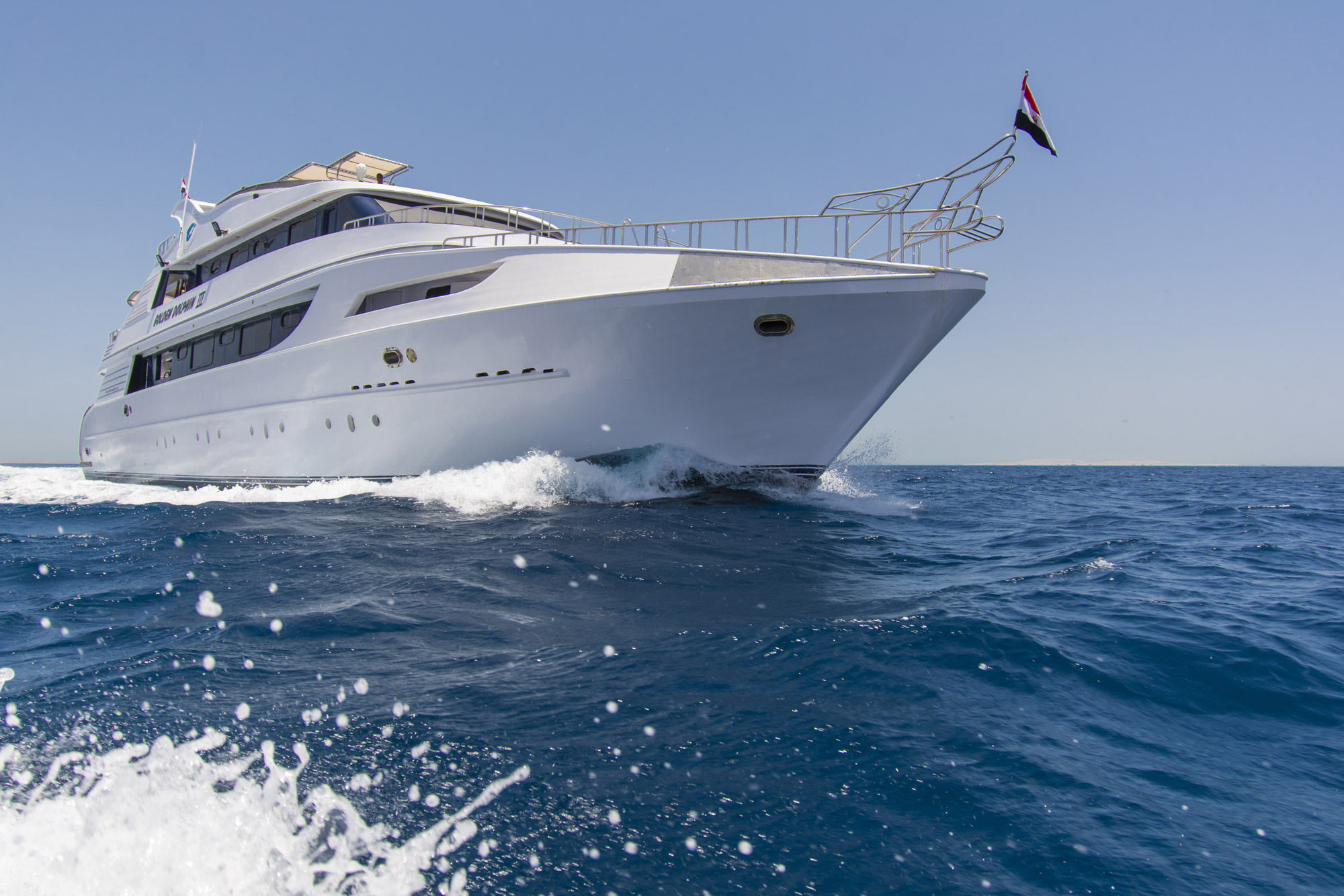日程安排
SS Turkia由Earles Shipbuilding and Engineering Co.于1909年在英格兰的Hall建造。这艘名为Livorno的蒸汽货船,全长91米,宽13米,重1671吨,在英格兰与北欧之间的各种贸易航线上使用。1920年至1935年间,这艘船被卖给希腊,并被更名为SS Turkia。1941年5月,SS Turkia从纽约前往比雷埃夫斯(Piräus),船上装载政府物资,包括爆炸物、陀螺、线圈、锭子、车辆、和武器等。在接近苏伊士运河(Channel of Suez)的地方沉没,原因有两种说法:船上起火或遭到轰炸。沉没在10米至24米的深度,满是软硬珊瑚,是潜水者从外到内探索这艘沉船的绝佳体验。
SS Thistlegorm可能是红海最著名的沉船。这艘英国货船正计划为北非的英军提供军事装备。然而,1941年10月6日,一架德国轰炸机袭击了该船。这艘沉船静卧在32米的海床上,特别是船上的货物:坦克、卡车、摩托车、武器、铁路车辆以及两台铁路机车,引人注目。
从西奈半岛东侧的北部开始是蒂朗海峡(Straits of Tiran),这也是红海最著名的潜水区之一。海峡中有四座珊瑚礁:戈登(Gordon)、托马斯(Thomas)、伍德豪斯(Woodhouse)、和杰克逊(Jackson)礁。戈登礁的标志是一艘大型商用货轮的沉船。礁石组合多样,有斑块区域,沙地以及完全成型的珊瑚花园。在礁斜坡的中心处有一个鲨鱼圆形剧场,或凹处,深达24米,潜水者有可能在沙地上看到各种鲨鱼物种。此地的珊瑚种类丰富,遍布大量分枝珊瑚,所有珊瑚都保存良好,成密集生长状态,常常显示出不同种类的惊人混合。虽然蒂朗海峡的鱼类并不算最丰富,但还是有一些惊喜,譬如一条身体比小潜水员腰部还粗的大型海鳝。引发鱼群大量出没,而剃刀鱼及鲹鱼成中等数量鲨鱼游开前的好群,天使鱼、鹦嘴鱼、和小型隆头鱼数量也相当可观。大的拿破仑鱼常能在礁边看到。
托马斯礁有些台地和沿南部延伸的一个很深的大峡谷,是蒂朗四礁中最小的一个。礁的上层斑驳多彩,云集了西奈地区最好的软珊瑚生长。巨大的软珊瑚田,遍布着Dendronephthya,包罗着所有可能的颜色,与鹿角珊瑚、细小的Stylophora、生长在一起的Acropora及其他许多石珊瑚。尽管小于20米深度的原因仅限于探索峡谷,鱼类也是丰富的,最大密度在浅水处。扇尾鳕鱼和其他石斑鱼长至很大的尺寸,各种兔鱼和隆头鱼群聚于礁面,伴随着箱型鱼和河豚。
伍德豪斯礁是一个长而窄的礁石,从东北向西南方向倾斜延伸。通常将伍德豪斯分为沿礁东侧漂浮的潜水点。整个礁石有着极好的珊瑚覆盖率,密集生长,约20米深度处有一些沙地斑块。由于其相对偏离主流的庇护位置,某些程度上的沉积影响了这里的珊瑚。包括大金枪鱼、涛鱼和军鱼、大量的其他礁鱼。
在杰克逊礁的北缘,一艘搁浅货船的残骸警示着繁忙海峡中的船只;船体大部分已被拆除回收,仅留下一具骨架。杰克逊礁的墙柱壁是西奈地区最好的之一,受强流影响的礁石密集生长着多样的硬软珊瑚,由繁盛的海扇、鞭珊瑚和黑珊瑚,以及鲜艳的软珊瑚增色。与此连带的鱼类数量也优异。强劲的流通为礁石和游走的鱼群提供了充足的营养;潮流和海图相结合诱引深邃的水域的浮游鱼类,巨大的鲹鱼和鲨鱼数量丰富。而这些浮游者吃的较小礁鱼种类也充足。
沙姆沙伊赫(Sharm el-Sheik)和亚喀巴(Aqaba)之间的中点即是达哈卜(Dahab),一个沿狭窄海岸线的地方,同时是湾区最深且最宽的地点。珊瑚礁大多为浅层,下降至约20-30米,例如在南部的绿洲或北方的大峡谷。尽管不适合所有人,峡谷拥有从15米开始最深出口达到50米的细长裂缝。在这之中仅有少量出口,故潜水方向趋向于洞潜,需要计划。即使是在浅水区,10米的沙地和碎石间也可以发现例外的鱼类,譬如伪装得极好的红海行走鱼和毒性石斑鱼,因而须小心。无害的侏儒翅鱼,体长可达8厘米,生活在5米内,同样难以发现。在达哈卜还可以到达非常好的珊瑚花园:在北方的国家公园被称为阿布加鲁姆(Abu Galum),南方的加布尔宾特(Gabr al Bint)以硬珊瑚和石斑鱼闻名。但一个地方使得达哈卜世界闻名:蓝洞(Blue Hole)。大约距离城市10公里北,是一个直径约50-70米且120米深的深蓝色圆洞。然而,蓝洞之外的峭墙长满美丽的植物,偶尔甚至可以看到大型鱼。被7米深的一个礁裂引入,其下一个突破点在56米,接着是26米长几米宽的拱,即超出我们浮潜者的极限,只有使用特殊气体混合物的Tekkies保留专属资格。
样本行程
第1天:
- 当您进入到达航站楼时,我们的接送操作员将举着Golden Dolphin Safari World的标志迎接您。他将为您处理签证(印章)并提供有关从机场到船的接送信息。长途接送时,我们提供午餐盒和饮品。
- 到达日当天晚上6:00入住船上。
第2天: 第3-9天:第10天: - 进行2次潜水,根据您的离境时间,建议在航班前保持24小时的水面时间,然后返回码头。
- 根据组织或出于技术原因,可能为客人提供最后一晚入住酒店的选项。
第11天:潜水行程将在旅行的倒数第二天结束。建议潜水员在最后一次潜水后等待24小时才搭乘飞机。
样本行程和地图仅用于说明目的,具体路线和访问地点可能会根据当地法规、游客体验、天气和后勤,依船长决定进行更改。
 微信扫码添加人工客服
微信扫码添加人工客服
